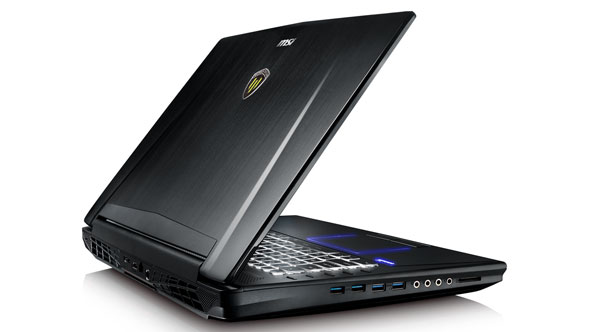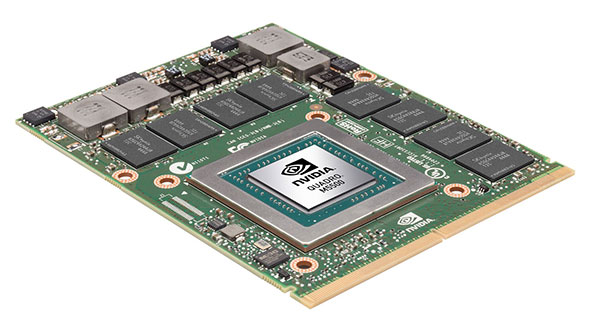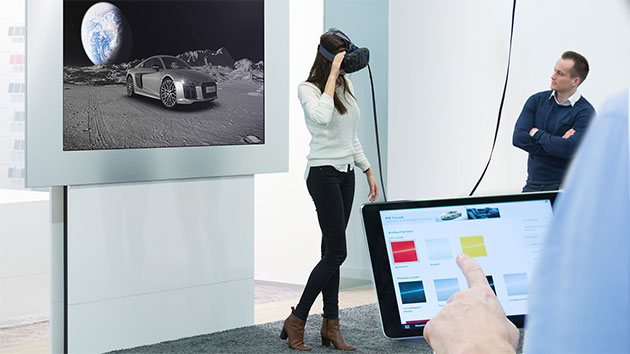Quadro Picks Its Desktop GPUs — and Even a Mobile Chip — That Are Beefy Enough for Virtual Reality
Following Dell's announcement of its "VR-ready" workstations last week, Nvidia has announced its "VR Ready Program for Professionals," which is designed to certify system-level hardware configurations that are capable of handling VR tasks, including development as well as playback in VR-enabled applications like Audi's VR Experience virtual showrooms (pictured, top).
Nvidia has worked with OEM partners including Dell, HP, Lenovo, Boxx, PNY, and Super Micro — as well as head-mounted display (HMD) manufacturers Oculus and HTC — to set standards for VR-ready hardware, the company said. On the desktop, Nvidia's Quadro M5000, M6000 and recently announced M6000 24 GB (in single-card or doubled up in SLI mode) all meet the criteria for the HTC Vive and the Oculus Rift. Among those manufacturers (and in addition to the previously announced Dell workstation systems), HP's Z-series workstations (including a Z840 loaded with dual M6000 24 GB GPUs) and Lenovo's P500, P710 and P910 are all available in VR-ready configurations meeting Nvidia's minimum requirements.

MSI's WT72 is being promoted as the first VR-ready mobile workstation.
Notably, the MSI WT72, a 17.3-inch notebook PC built with Nvidia's 2048-core Quadro M5500 and 8 GB of GPU memory, is being billed as the first VR-ready mobile workstation — at least it will be when it goes into production next month. "[The M5500] is a beast," Nvidia's Sandeep Gupte, who heads product marketing for the Quadro graphics line, told StudioDaily. "It's super-fast. It's absolutely the fastest mobile GPU in our line-up now — a desktop GPU that we're squeezing into a mobile form factor."

Nvidia's Quadro M5500 GPU is an early cornerstone of mobile VR-ready workstations.
The issue of VR's hardware requirements came to the fore as early adopters discovered that the minimum recommended system configuration for running the Oculus Rift headset included surprisingly beefy CPU and GPU requirements. A hardware bottleneck can make VR playback an iffy proposition for creators and consumers alike. "
Chief among the factors driving hardware requirements for VR is the sheer quantity of video information being pumped through the different components of a system. Gupte noted that 1080p video at 30 fps requires a system to deal with a little over 60 megapixels per second. But a typical VR experience running at 90 fps with video resolution of 3024×1680 (render resolution of a LT/RT stereo image) is an almost eightfold increase, to more than 450 megapixels per second. Latency is an issue, as well, with Nvidia requiring latency between the motion of a VR HMD and the corresponding photon reaction in fewer than 20 ms.
Pixel-Pushing: HD Video vs. VR
| 1080p HD @ 30fps | (1920×1080) * 30 = 62,208,000 pixels/second |
| Stereo VR @ 90fps | [(1512×1680) + (1512×1680)] * 90 = 457,228,800 pixels/second |
Source: Nvidia
Asked about the likelihood that Nvidia's just-announced VR-Ready specifications would change by this time next year, Gupte agreed it's a certainty that standards and expectations will evolve quickly.
"It's going to move at a quick pace, and every year you're going to see big jumps in performance and capability," he said. "All the work we're going to be doing with our partners and with our developers is going to make these experiences even more accessible, perhaps at lower cost points for many people. No matter what kind of use case you have, consumer or professional, it's going to keep getting better and faster with every generation of hardware and software."
Crafts: Post/Finishing
Sections: Technology
Topics: New product gpus mobile gpus NVIDIA VR workstations
Did you enjoy this article? Sign up to receive the StudioDaily Fix eletter containing the latest stories, including news, videos, interviews, reviews and more.











Leave a Reply